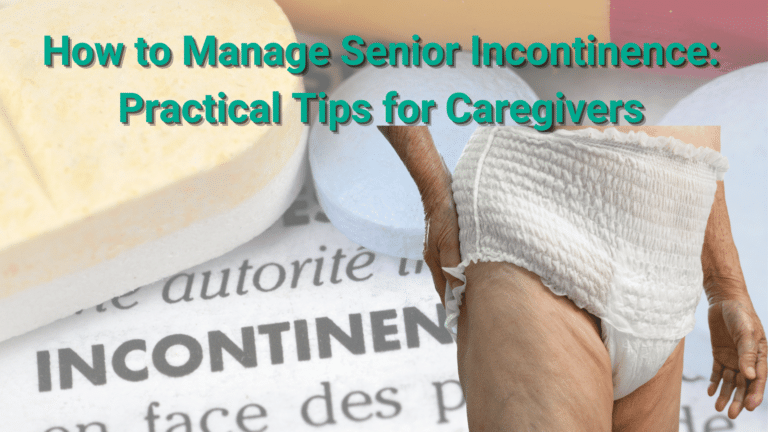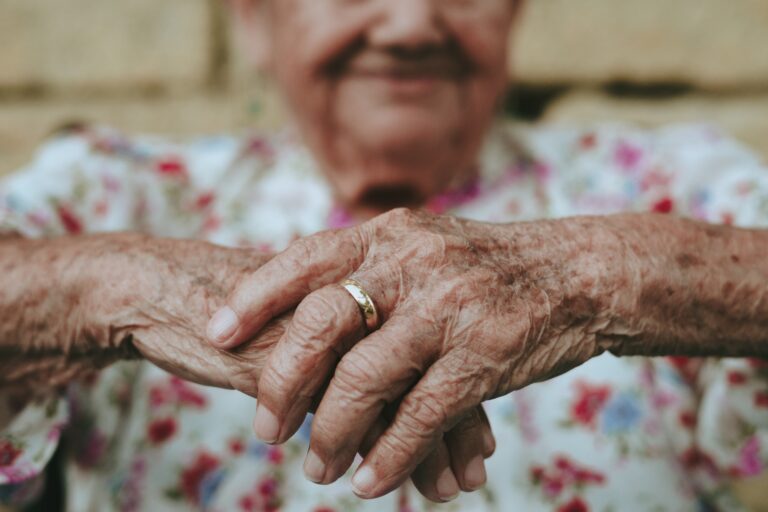Recently, one of our clients was on hospice. She had a broken hip and was bed bound. Changing her would be a challenge, especially overnight when there would only be one caregiver. One of my rockstar caregivers came up with an idea of how to set her up to make this challenge super easy! By folding a second brief backwards, and placing it strategically, the lone caregiver was able to keep our client dry and comfortable with ease.
Incontinence affects millions of seniors, and while it may feel embarrassing, it’s a condition that can be managed. In fact, urinary incontinence affects more than half of middle-aged women and up to 80% of women over 80 years old. Incontinence is also a leading cause of admission to nursing homes and skilled care settings. Understanding the different types of incontinence and knowing the right management strategies can make a significant difference in daily life. Whether you’re personally experiencing incontinence or caregiving for a loved one, this guide offers senior incontinence management tips to help you along the way. The self reported prevalence of urinary incontinence among persons aged 65 and older was estimated at only 6-8% annually from 2012 to 2021, suggesting significant underreporting.
Understanding Senior Incontinence: Types and Causes
Before diving into how to manage incontinence, it’s important to understand the types of senior incontinence. Each type has its own causes and specific treatment options:
- Urge Incontinence: A sudden and overwhelming urge to urinate, often caused by an overactive bladder. Seniors with this type may not make it to the bathroom in time.
- Stress Incontinence: This happens when physical activities like coughing, sneezing, or lifting put pressure on the bladder, causing leaks. It’s more common in women post-childbirth or menopause.
- Overflow Incontinence: Frequent dribbling caused by a bladder that doesn’t empty completely. This is common in men with an enlarged prostate.
Identifying which type of incontinence you or your loved one is experiencing is crucial to finding the most effective management plan.
Non-Invasive Treatment Options for Senior Incontinence
There are a variety of incontinence treatment options for seniors, and non-invasive therapies are often the first line of defense. A 12-week study showed that low-impact yoga and exercise reduced daily episodes of urinary incontinence by more than half in older women. These can significantly improve control and reduce the frequency of accidents:
1. Bladder Training Techniques
One of the most effective behavioral therapies for senior incontinence is bladder training. This involves keeping a log of bathroom trips and gradually increasing the time between visits to help retrain the bladder to hold more urine.
2. Pelvic Floor Exercises (Kegels) for Seniors
Pelvic floor exercises strengthen the muscles that control urination. These simple exercises can be done daily and are especially helpful for managing stress incontinence in seniors.
3. Diet and Fluid Adjustments for Incontinence Management
Diet management plays a big role in controlling incontinence. Avoiding diuretics like caffeine and alcohol, and drinking fluids steadily throughout the day (instead of all at once) can help reduce urgent trips to the bathroom.
Medical Treatments for Senior Incontinence: Medications and Surgeries
If behavioral strategies alone don’t work, medical treatments for senior incontinence are available. It’s important to consult with a doctor to determine the best path forward.
Medications for Senior Incontinence
Certain medications, such as anticholinergics, can help relax the bladder and reduce overactivity, while alpha-blockers can ease the muscles in the prostate and bladder, which is particularly helpful for men with overflow incontinence.
Surgical Options for Incontinence
For more severe cases, you may want to explore surgical interventions for incontinence. There are three main types of incontinence surgeries: injections, urethral sling, or colposuspension. These procedures help support the bladder and prevent leaks, significantly improving quality of life for those affected.
Creating a Senior-Friendly Home Environment for Incontinence Management
Home modifications can make managing incontinence much easier and safer. Here are a few practical tips for caregivers managing senior incontinence:
- Install grab bars: Place them in the bathroom to assist with stability during late-night trips.
- Use incontinence products: Absorbent pads, briefs, and bed protectors help manage leaks and maintain hygiene. Here is a list of some of our most recommended: Large washable underpads, Tena ProSkin breathable briefs, disposable chucks, and skin protective paste. Don’t forget to explore adaptive clothing for incontinence if they prefer to be dressed daily to minimize accidents.
- Prepare a to-go kit: For outings, pack a small bag with wipes, disposable gloves, and a change of clothes for peace of mind.
A safe, supportive home environment can help reduce anxiety and prevent accidents, allowing seniors to live with dignity..
Emotional Support for Seniors and Caregivers Facing Incontinence
The emotional toll of incontinence can be significant. Many seniors feel embarrassment or frustration, and caregivers may struggle with feelings of guilt or helplessness. But emotional support is as important as physical care.
- Encourage open conversations: Talking openly about incontinence can help reduce feelings of shame. This helps both the senior and the caregiver work together as a team to manage the condition.
- Join a support group: Connecting with others who are experiencing similar challenges can provide emotional relief and practical advice for managing senior incontinence.
- Care for the caregiver: As a caregiver, it’s important to look after your own mental and physical health. Make time for activities you enjoy, seek help when needed, and stay connected with your support network.
When to Seek Professional Help for Senior Incontinence
If senior incontinence starts to interfere with daily activities or causes distress, it’s important to seek help from a healthcare provider. Specialists can offer advanced incontinence treatment options and help tailor a plan that suits your needs.
A professional evaluation will provide peace of mind and ensure that you or your loved one are getting the best care possible.
Practical Tips for Caregivers: How to Manage Senior Incontinence
As a caregiver, managing someone else’s incontinence can be daunting. Here are some caregiving tips for senior incontinence to make daily routines smoother:
- Stick to a schedule: Create a routine that includes bathroom breaks at regular intervals, especially after meals or before bed.
- Prevent skin irritation: Keep the skin clean and dry by using mild soap and applying a barrier cream to avoid rashes or irritation.
- Stay calm and patient: Incontinence can be frustrating for both you and your loved one. Stay calm, and offer gentle reassurance that together, you can manage the situation. Remember, gentle encouragement and support go a long way in making them feel understood and cared for.
Key Takeaways on Managing Senior Incontinence
- Senior incontinence is manageable with the right approach, from behavioral strategies to medical treatments.
- Non-invasive treatments like bladder training and pelvic floor exercises should be the first step.
- Medical and surgical options are available for severe cases and can greatly improve quality of life.
- Creating a safe home environment is essential for managing incontinence with dignity and comfort.
- Emotional support and open communication are key to reducing the stigma around incontinence for both seniors and caregivers.
By taking these steps, you can help ensure that senior incontinence doesn’t define daily life. Whether you’re caring for a loved one or managing your own incontinence, remember that there are many tools, strategies, and resources available to help you or your loved one live comfortably and confidently.
Final Thoughts: Share Your Tips and Stories!
Have you or a loved one managed senior incontinence successfully? Share your tips and stories in the comments or on our social media channels to help others navigating this journey. Together, we can make managing incontinence easier and less stressful for everyone.

From a young age, Stacey’s link to the senior care industry grew alongside her mother’s work at a nursing home, where she often accompanied her. By her early teens, she secured her first official job at a nursing home, laying the foundation for a profound journey in senior care spanning over four decades. Her roles varied from opening assisted living and memory care residences to working in nursing homes and independent senior living communities. As the former Director of Fun for 300 independent seniors, she expertly organized daily events and trips. Stacey’s unwavering passion, nurtured by her family, and professional dedication as a recreation therapist, reflect her deep commitment to preserving the dignity and well-being of seniors.
Stacey’s senior care expertise has been recognized by the media including U.S. News and World Report and Care.com.
Stacey and her husband Bryan are the owners of the senior in-home care agency A Place At Home – North Austin.




